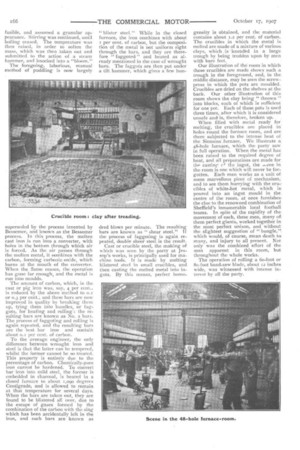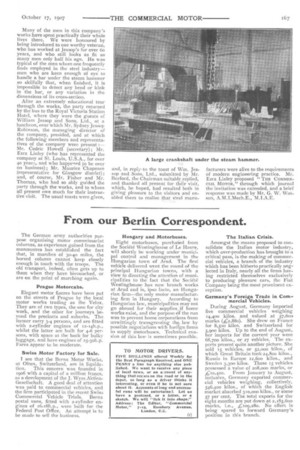A Visit to Jessop's Steel Works.
Page 27

Page 28

Page 29

If you've noticed an error in this article please click here to report it so we can fix it.
On Trials Wednesday, Sheffield, at the invitation of William jessop and Sons, Ltd., "THE COMMERCIAL MOTOR" omnibus piloted a representative party of motor manufacturers to .that company's Brightside works. The party, twenty in number, was received at the works by Mr.
. riSher, the works manager, and his assistant, Mr. W. Fl. Thomas. . The Latter gentleman is more particularly responsible for the department whieh caters for the motor industry, a department which daily becomes more important. It was through the courtesy of Mr. Thomas that the visit was arranged.
Each member of the party was presented with a neat little souvenir, in the shape of a penknife made of jessop steel, and was then shown the various stages of steel manufacture. The chief steps in this interesting process will, perhaps, be better appreciated by many Of our readers if we now briefly outline the stages from the first smelting of the ore to the casting of the huge ingots from which are made so many important details of modern machines. Most of the steel used to-day is obtained from clay iron-stone, which is a ferrous carbonate mixed with clay. This ore is first calcined by the atmosphere, when put in a blast furnace with alternate layers of coke and limestone, and then smelted. The metal in the ore settles to the bottom of the furnace, and is run off into moulds called pigs, and the re_ suiting bars are called pig iron, or cast iron. In this condition, the metal is very impure; it contains from 2 to 5 per cent, of carbon, which makes the iron extremely brittle and unsuitable for general use.
In order to convert this cast iron into wrought iron, it is necessary to remove some of the carbon which is present, and this may be done in one of two ways. The original method was by puddling. The pig-iron was first refined, by being melted in a current of air which had passed over hot coke ; the refined iron was next mixed with "black scales "or, to give it its proper name, oxide of iron, and was then put into a puddling furnace. When the mass had melted, it was stirred, or puddied, and it soon had the appearance of soiling, owing to the passing-off of some of the carbon as carbonic oxide. As the percentage of carbon decreased, the mass became less
fusible, and assumed a granular ap-pearance. Stirring was continued, until. boiling ceased. The temperature was then raised, in order to soften the mass, which was then taken out and submitted to the action of a steam hammer, and knocked into a "bloom."
The foregoing, laborious, manual method of puddling is now largely superseded by the process invented by Bessemer, and known as the Bessemer process. In this process, the molten cast iron is run into a converter, with holes in the bottom through which air is forced. As the air passes through the molten metal, it combines with the carbon, forming carbonic oxide, which burns at the mouth of the converter. When the flame ceases, the operation has gone far enough, and the metal is run into moulds.
The amount of carbon, which, in the cast or pig iron was, say, 4 per cent., is reduced by the above method to o.t Or 0.3 per cent.; and these bars are now improved in quality by breaking them up, tying them into bundles, or faggots, for heating and rolling : the resulting bars are known as No. 2 bars. The process of faggoting and rolling is again repeated, and the resulting bars are the best bar iron and contain about o.t per cent. of carbon.
To the average engineer, the only difference between wrought iron and steel is that the latter can be tempered, whilst the former cannot be so treated. This property is entirely due to the percentage of carbon. Chemically-pure iron cannot be hardened, To convert bar iron into mild steel, the former is embedded in charcoal, is heated in a closed furnace to about 1,090 degrees Centigrade, and is allowed to remain at that temperature for several days. When the bars are taken out, they are found to be blistered all over, due to the escape of gases formed by the combination of the carbon with the slag which has been accidentally left in the iron, and such bars are known as
" blister steel.'' • While in the closed furnace, the iron combines with about T per cent. of carbon, but the composition of the metal is not uniform right through the bars, and they are therefore " faggoted " and heated as already mentioned in the case of wrought bars. The faggots are then put under a tilt hammer, which gives a few bun
dred blows per minute. The resulting bars are known as " shear steel." If the process of faggoting is again repeated, double sheer steel is the result.
Cast or crucible steel, the making of which was seen by the party at Jessop's works, is principally used for machine tools. It is made by melting blistered steel in small crucibles, and then casting the melted metal into ingots. By this means, perfect home geneity is obtained, and the material contains about 1.2 per cent, of carbon. The crucibles in which the metal is melted are made of a mixture of various clays, which is "kneaded in a large trough by being ttodden upon by men with bare feet.
Our illustration of the room in which these crucibles are made shows such a trough in the foreground, and, in the middle distance, may be seen the screwpress in which the pots are moulded. Crucibles are dried on the shelves at the back. Our other illustration of this room shows the clay being "thrown into blocks, each of which is sufficient for one pot. Each of these pots is used three times, after which it is considered unsafe and is, therefore, broken up.
When filled with metal ready for melting, the crucibles are placed in holes round the furnace room, and arethere subjected to the intense heat ofthe Siemens .furnace. We illustrate a. 48-hole furnace, which the party saw• in full operation. When the metal has been raised to the required degree of heat, and all preparations are made for th.P casting cc the ingot, the ,,,ene in the room is one which will never be forgotten. Each man works as a unit of some marvellous piece of mechanism, and to see them hurrying with the cru-• ell:des of white-hot metal, which is• poured into an ingot mould in the centre of the room. at once furnishes. the clue to the renowned combination of. Sheffield's innumerable local football. teams. In spite of the rapidity of the movement of each, these men, many of: them perfect giants, worked together in the most perfect -unison, and without. the slightest suggestion of " bungle,"' which would, of course, mean death to many, and injury to all present. Not only was the combined effort of the men apparent in this room, but throughout the whole works.
The operation of rolling a 6o-foot or 8o-foot band-saw blade, about 12 inches wide, was witnessed with intense interest by all the party.
Many of the men in this company's works have spent practically their whole lives there. We were honoured by being introduced to one worthy veteran, who has worked at Jessop's for over 6o years, and who still looks as fit as many men only half his age. He was typical of the men whom one frequently finds employed in the steel industry— men who are keen enough of eye to handle a bar under the steam hammer so skilfully that, when finished, it is impossible to detect any bend or kink in the bar, or any variation in the dimensions of its cross-section.
After an extremely educational tour through the works, the party returned by the bus to the Royal Victoria Station Hotel, where they were the guests of William Jessop and Sons, Ltd., at a luncheon, over which Mr. Sydney Jessop Robinson, the managing director of the company, presided, and at which the following members and representatives of the company were present :Mr. Cedric Howell (secretary); Mr. Ezra Linley (who has represented the company at St. Louis, U.S.A., for over 40 year3,. and who happened to be over on business); Mr. Maurice Chapman (representative for Glasgow district); and, of course, Mr. Fisher and Mr. Thomas, who had so ably guided the party through the works, and to whom all present owe much for their instructive visit. The usual toasts were given,
and, in repli, to the toast of Wm. Jessop and Sons, Ltd., submitted by Mr. Burford, the Chairman suitably replied, and thanked all present for their visit, which, he hoped, had resulted both in giving pleasure to the visitors and enabled them to realise that steel manu facturers were alive to the requirements of modern engineering practice. Mr. Ezra Linley proposed "THE COMMERCIAL MOTOR," through which journal the invitation was extended, and a brief response was made by Mr. G. W. Watson, A.M.I.Mech.E., M.I.A.E.






























